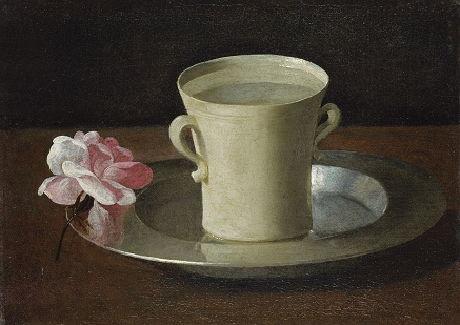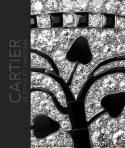Art Of The Day Weekly
#331 - from 30 January 2014 to 5 February 2014

Francisco de Zurbarán, A Cup of Water and a Rose, ca. 1630, oil on canvas, 21,2 x 30,1 cm, National Gallery, London.
IN THE AIR
Zurbarán, a Spanish master
BRUSSELS – He did suffer from being in the shadow of the great Vélasquez, Greco and – a little less than before though - that of Murillo, all three his contemporaries. But Zurbarán (1598-1664), the ‘Spanish Caravaggio’ had admirers who were very picky, who saw his dark painting as the best of two worlds: an extraordinary savings of means (which brought him close to Sánchez Cotán or Goya), at the same time as a mystic elevation (which put him close to the Greco). This retrospective, already presented in a different form at Ferrara, will show the variety of his talents. The artist was born in the most remote region of Spain, the region of Estremadura which bore so many conquistadors, and was capable of strict still lives, of large religious compositions full of pathos, and of portraits of princes and saints who looked like real fashion prints.
• Francisco de Zurbarán, at Bozar, from 29 January to 25 May 2014.
EXHIBITIONS

Giulio Aristide Sartorio, The Mermaid, 1893, oil on canvas, Turin, GAM - Galleria d’Arte Moderna e Contemporanea.
Liberty, another version
FORLÌ –It was the name that englobed Art nouveau in Italy at the beginning of the 20th century, a cousin of Modern Style and of the Jugensdtil. It spread thanks to major exhibitions, such as the one of Torino in 1902 with an international echo, and that of Milano four years later, that celebrated an engineering feat, the opening of the tunnel of Simplon. While the reputation of its decorative art and architecture crossed borders , with Ettore Bugatti as an emblematic figure, the painters were less known abroad. The exhibition will allow us to rediscover Previati, Tallone and Sartorio, rarely seen in international retrospectives. Visitors shuld then not hesitate to go for a walk to explore the traces left in the region, from the café Alla Vittoria to villa Sardi, and even the Lucarelli palace at Castrocaro Terme.
• From 1 February to 15 June 2014
OTHER EXHIBITIONS NOT TO BE MISSED
Redon, symbol and colour
BASEL – He is easily classified as a Symbolist, but Odilon Redon, a solitary creator, also cleared the way for the Surrealists and was a great colourist artist (illustration: Odilon Redon, Ophélie, 1900-05, pastel on paper on cardboard, 50.5 x 67.3 cm. Collection Dian Woodner, New York, photo: Lynton Gardiner). From 2 February to 18 May 2014
At the origins of the mine
LEWARDE – In 1712, the Historical mining Centre shows how the battle of Denain, one of the last episodes of the Spanish War of Succession, triggered off the beginning of the mine production that was to mark the region for nearly three centuries. From 1 February to 30 March 2014.
Cézanne, in and out
MADRID – He loved indoor lights as well as the calm of still lives: this double Cézanne is the object of a retrospective at the Thyssen-Bornemisza museum. From 4 February to 18 May 2014
Fini, from beginning to end
UMEA (Sweden) – An exhibition of the Surrealist artist of Argentine origin, Leonor Fini, at the Bildmuseet, launches the program of one of the two European 2014 cultural capitals (the other is Riga). From 31 January to 11 May 2014
AUCTIONS

Edgar Degas, Femme s'essuyant les pieds, pastel on paper laid down on board, 45.7 by 58cm (18 by 22 7/8 in.), executed circa 1893. Estimate: £1,000,000 — 1,500,000.
The Krugier sale
LONDON – Impressionist art haunts museums. But some samples are still in private hands, as we will learn in this exhibit at the exhibition at the musée Marmottan Monet, as of 13 February. The great winter auctions prove opportunities still exist for those who have the means. At Sotheby's in London, on 5 February r, we can treat ourselves, for an estimated €1.2 million, Femme s'essuyant les pieds, a superb pastel by Degas from 1893, sold in 1918 during the second Degas workshop auction, and which belonged to the Comiot and Wildenstein collections. There are also some beautiful works by Cézanne (Femme assise) and Monet (Au bord du fjord). This exceptional group is not a simple coincidence. It is the fruit of a long investigation by an art dealer from Geneva Jan Krugier (1928-2008). Everyone will be looking at the bids (a first ensemble had gone for more than €100 million in November 2013 at Christie's) while everyone wonders about the aim of the Jan Krugier foundation, created in December 2010 to ‘ensure the conservation and the value of the collection of works of art assembled by Jan Krugier"...
• Collection Jan Krugier and Marie-Anne Krugier-Poinatowski at Sotheby's on 5 and 6 February 2014.
ARTIST OF THE WEEK
Jeremy Hutchison, the deconstructed image
Do images still make any sense? Their monumental storage grows out of size and we are bombarded to such a point that strangely enough, we forget them very quickly or do not even see them. If we want them to tell us something, we need to pull them away from their context, turn them around, repeat this a thousand times. That is what Jeremy Hutchison (born in 1979) does. He has the training of a linguist who hunts the hidden sense of what seems natural to us. The same applies for a simple shopping spree to the supermarket, rewound, a daily act. A car runs all night long around a roundabout; the artist pays a person to walk around with a mirror in which he sees himself. The company Erratum introduces a mistake in each object it produces. All these are absurd reflections with a reason for being: make us think of the mother image.
• Jeremy Hutchison presents the installation I- à Rurart (86480 Rouillé), from 30 January to 27 April 2014.
OPENINGS OF THE WEEK

BOOKS
The Cartier spirit
It is undoubtedly one of the brands that best symbolises the world of luxury. Its Tank and Santos-Dumont watches are icons and status symbols. But the Cartier house, founded in 1847, is not limited to its famous accessories and closely accompanied the Art nouveau and in particular the Art deco movements. This catalogue that accompanies the exhibition at the Grand Palais (until 16 February 2014), will open the archives of rue de la Paix (the Parisian headquarters that opened in 1899, a year after its neighbour, the Ritz hotel) and of international collections. It illustrates unique pieces, by associating them as much as possible with the stars that wore them or ordered them: Grace Vanderbilt, Barbara Hutton, Gloria Swanson (and her rock crystal bracelets), Wallis Simpson, Jean Cocteau (his sword of the French Academy in 1955), Maria Félix (her Snake necklace with 2473 diamonds) or the maharajah of Patiala. The house produced for this same Indian Prince, between 1925 and 1928, the undoubtedly most impressive ceremony necklace in history: a cascade of three thousand diamonds around a yellow, 234 Carat diamond. It was found again by chance in 1998, and was recently recreated based on the original plans. Luxury can also be not worrying about time.
• Cartier, le style et l’histoire, directed by Laurent Salomé and Laure Dalon, Réunion des musées nationaux/Grand Palais, 2013, 400 p., €45
ON ART-OF-THE-DAY.INFO
This week, do not miss

ESPRIT MONTMARTRE BOHEMIAN LIFE IN PARIS AROUND 1900
FRANKFURT - The Schirn Kunsthalle presents more than 200 works, from Degas and Toulouse-Lautrec to Picasso, on the quarter of Montmartre with its stories and protagonists.



